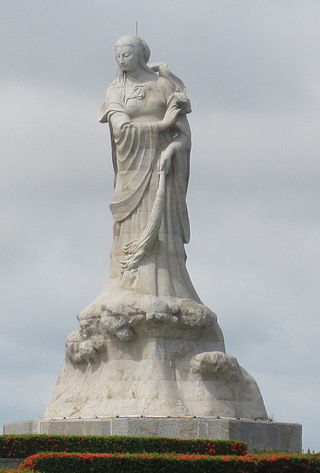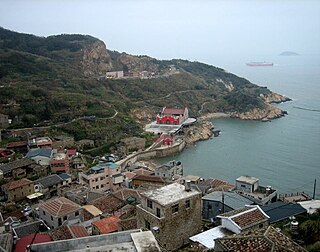
Mazu or Matsu is a Chinese sea goddess in Chinese folk religion, Chinese Buddhism, Confucianism, and Taoism. She is also known by several other names and titles. Mazu is the deified form of Lin Moniang, a shamaness from Fujian who is said to have lived in the late 10th century. After her death, she became revered as a tutelary deity of Chinese seafarers, including fishermen and sailors. Her worship spread throughout China's coastal regions and overseas Chinese communities throughout Southeast Asia, where some Mazuist temples are affiliated with famous Taiwanese temples. Mazu was traditionally thought to roam the seas, protecting her believers through miraculous interventions. She is now generally regarded by her believers as a powerful and benevolent Queen of Heaven.

Suzhou is a city in southern Jiangsu of eastern China.

Chongming District is the northernmost district of the provincial-level municipality of Shanghai. Chongming consists of three low-lying inhabited alluvial islands at the mouth of the Yangtze north of the Shanghai peninsula: Chongming, Changxing, and Hengsha. Following its massive expansion in the 20th century, Chongming is now the 2nd-largest island administered by the People's Republic of China and the 2nd-largest in Greater China, after Hainan. Chongming does not, however, administer all of the island: owing to its continual expansion from sediment deposited by the Yangtze, it has merged with formerly separate islands and now includes Jiangsu province's pene-exclave townships of Haiyong and Qilong. Chongming proper covers an area of 1,411 km2 (545 sq mi) and had a population of 637,921 at the time of the Census 2020.

Nangan Township is a rural township in the Matsu Islands and the county seat of Lienchiang County, Fujian.

Songjiang is a suburban district of Shanghai. It has a land area of 605.64 km2 (233.84 sq mi) and a population of 1,909,713 (2020). Owing to a long history, Songjiang is known as the cultural root of Shanghai.

Beihai Park is a public park and former imperial garden immediately northwest of the Forbidden City in Beijing, China.

The Yonghe Temple, also known as the Yonghe Lamasery, or popularly as the Lama Temple, is a temple and monastery of the Gelug school of Tibetan Buddhism located on 12 Yonghegong Street, Dongcheng District, Beijing, China. The building and artwork of the temple is a combination of Han Chinese and Tibetan styles. This building is one of the largest Tibetan Buddhist monasteries in China proper. The current abbot is Lama Hu Xuefeng.
Articles related to Taiwan include:

Guwenhua Jie, Tianjin's Ancient Culture Street, is a pedestrian pathway complex dotted with temple gates and kiosks on the west bank of the Hai River in Tianjin, China. The Nankai District area is classified as a AAAAA scenic area by the China National Tourism Administration.
Yan Yikuan, formerly known as Yan Kuan and also known as Kevin Yan, is a Chinese actor and singer. He is best known for his roles in the television series Taiji Prodigy (2002), The Prince of Qin, Li Shimin (2005), The Last Princess (2008), All Men Are Brothers & The Glamorous Imperial Concubine (2011), Mazu (2012), Heroes in Sui and Tang Dynasties (2013), The Three Heroes and Five Gallants (2016) and Treasure Raiders (2016).

The Songjiang Square Pagoda or Songjiang Fangta, officially the Xingshengjiao Temple Pagoda, is a Buddhist pagoda in the old town of Songjiang in suburban Shanghai. Originally built in the 11th century, it is the only structure remaining from the Xingshengjiao Temple, and is now enclosed in the Fangta Park. The 9-story pagoda is 48.5 meters (159 ft) tall, and it has become Songjiang's most famous landmark.
Chen Peiqiu was a Chinese calligrapher and guohua painter, often acclaimed as the foremost Chinese woman painter. She and her husband Xie Zhiliu were one of the most famous couples in Chinese visual arts. The government of Shanghai opened a museum in Nanhui New City dedicated to them.

The East Zhejiang Maritime Affairs/Folk Custom Museum is a museum located in Yinzhou District in Ningbo, Zhejiang, China. It is located in the Qing'an Guildhall, a reconstructed complex which once housed a temple to the sea-goddess Mazu. Originally built in 1191, the complex was destroyed and rebuilt several times. After its mid-19th century restoration by Ningbo's guild of Fujianese merchants, it was acclaimed as one of the most beautiful temples in China and was used by the merchants as their guildhall. It was destroyed in 1949 as the Communists were fighting the Chinese Civil War, and suffered further harm during the Cultural Revolution, but was repaired from 1997 to 2001. It reopened in June 2001 as a museum dedicated to eastern Zhejiang's maritime history and local arts and crafts.
Huangshi Town is a town in Putian's Licheng District on the central coast of Fujian Province, China. It had about 148,000 people during the 2010 census.

The Grand Matsu Temple, also known as the Datianhou or Great Queen of Heaven Temple, is a temple to the Chinese Goddess Mazu, who is the Goddess of Sea and Patron Deity of fishermen, sailors and any occupations related to sea/ocean. The temple is located in the West Central District of Tainan on Taiwan.

Yuquan Temple, formerly known as Palace of the Goddess, is a Buddhist temple located in Tianxin District of Changsha, Hunan.

Beidou Dian'an Temple is a temple located in Beidou Township, Changhua County, Taiwan. The temple is dedicated to the sea goddess Mazu, who is the deified form of Lin Moniang.

Guan'ao Longfeng Temple is a temple located in Jinsha Township, Kinmen County, Fujian. The temple's main deity is the sea goddess Mazu.














